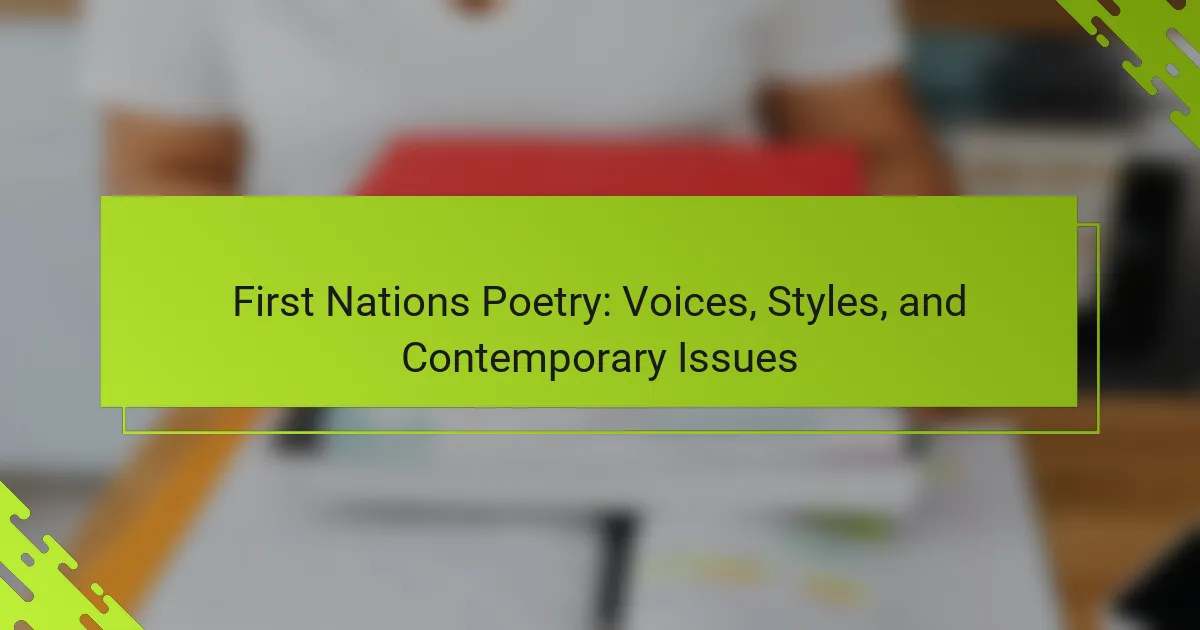First Nations poetry serves as a vital expression of cultural identity and contemporary issues faced by Indigenous peoples. This article explores prominent voices shaping the genre, diverse poetic styles, and the social justice themes that resonate throughout the works. It also examines the challenges poets encounter, including cultural appropriation and limited publishing opportunities. Additionally, the impact of digital platforms on the visibility of First Nations poetry will be discussed.
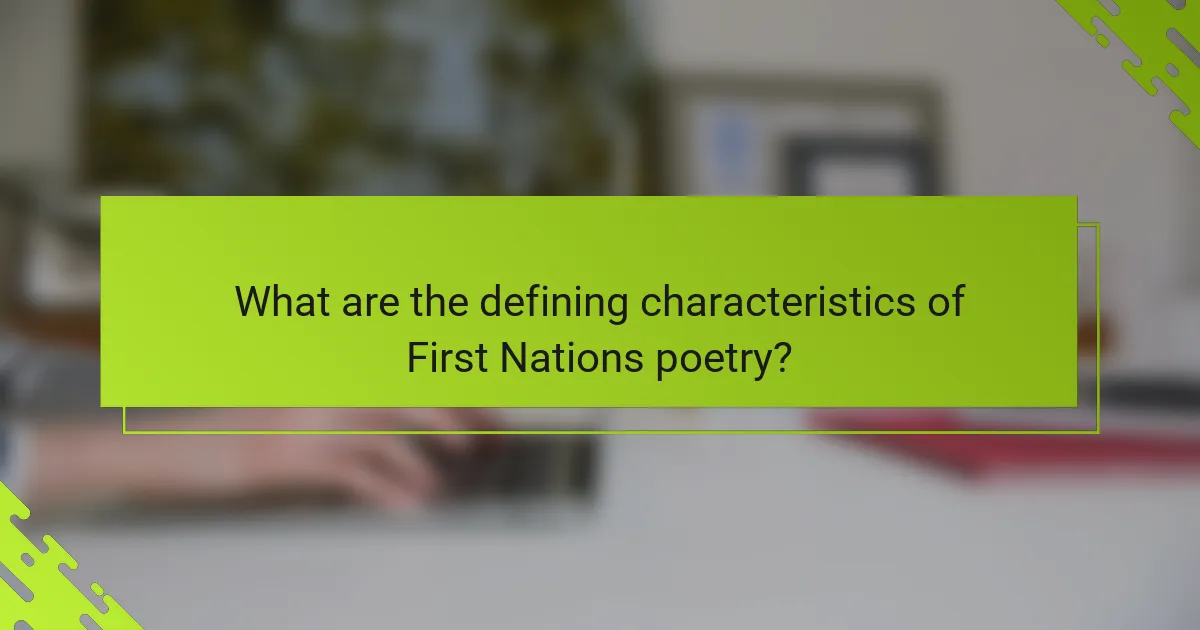
What are the defining characteristics of First Nations poetry?
First Nations poetry is characterized by its deep connection to cultural identity, oral traditions, and contemporary social issues. It often incorporates unique storytelling methods, symbolism, and a blend of traditional and modern styles. These poems reflect the lived experiences of Indigenous peoples, addressing themes such as resilience, nature, and community. The use of language varies, with some poets integrating native languages to preserve cultural heritage. Overall, First Nations poetry serves as a powerful medium for expressing the complexities of Indigenous life and advocating for social justice.
How does cultural heritage influence poetic expression?
Cultural heritage profoundly shapes poetic expression in First Nations poetry by infusing it with unique voices, styles, and contemporary issues. The connection to ancestral traditions, language, and storytelling methods enriches the thematic depth and emotional resonance of the poetry.
First Nations poets often reflect their cultural identities through symbols, imagery, and traditional forms, which serve as vehicles for expressing community values and historical experiences. For example, the use of nature motifs frequently symbolizes the relationship between the land and Indigenous identity.
Contemporary issues such as colonization, identity, and resilience are woven into the fabric of these poems, creating a dialogue between past and present. This interplay not only honours cultural heritage but also advocates for social justice and environmental stewardship, making the poetry relevant to today’s societal challenges.
In summary, cultural heritage is a vital attribute of First Nations poetry, influencing its content, style, and purpose, while addressing both personal and collective experiences.
What themes are prevalent in First Nations poetry?
First Nations poetry often explores themes of identity, cultural heritage, and connection to the land. It reflects the struggles and resilience of Indigenous peoples, addressing contemporary issues such as colonization, environmental stewardship, and social justice.
Another prevalent theme is the celebration of community and family ties, emphasizing the importance of relationships in Indigenous cultures. Poets frequently use traditional storytelling techniques and language to convey their messages, creating a rich tapestry of voices and styles.
Additionally, First Nations poetry often incorporates elements of spirituality and the natural world, illustrating the deep interconnection between people and their environment. This thematic diversity enriches the literary landscape, offering insights into the lived experiences of Indigenous communities.
How do oral traditions shape written forms?
Oral traditions significantly influence written forms by preserving cultural narratives and styles. First Nations poetry showcases this connection through storytelling techniques and rhythmic patterns rooted in oral practices. The transition to written forms allows for broader dissemination, yet the essence of oral traditions remains vital. Contemporary issues reflect the ongoing dialogue between preserving these traditions and adapting them to modern contexts.
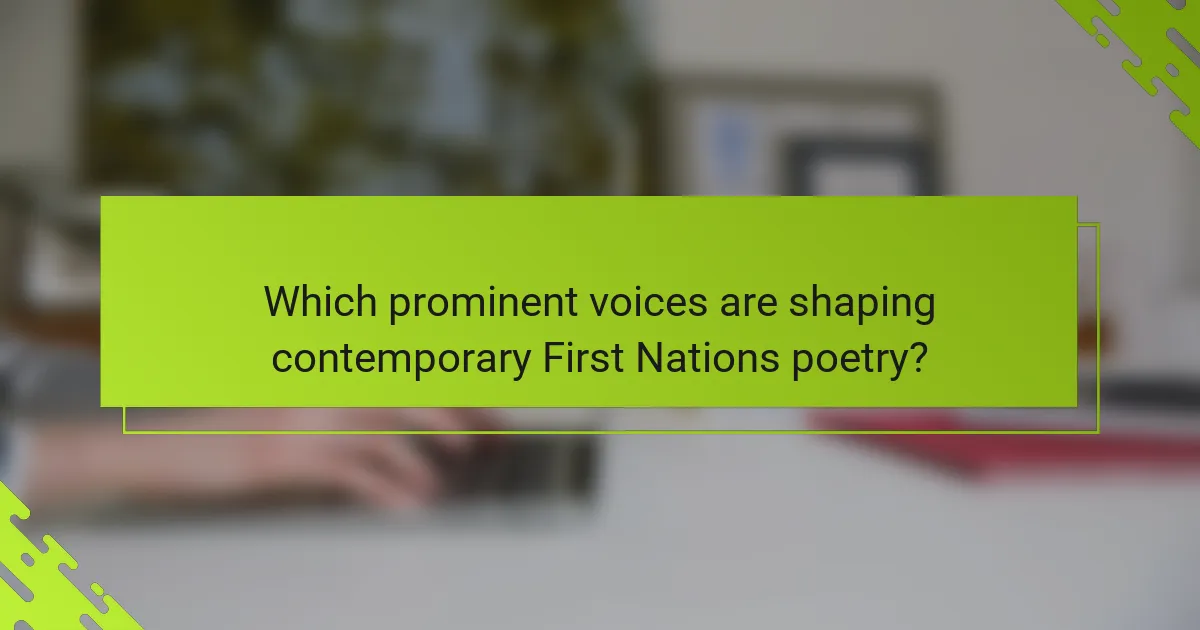
Which prominent voices are shaping contemporary First Nations poetry?
Prominent voices shaping contemporary First Nations poetry include poets like Lee Maracle, who emphasizes Indigenous storytelling, and Ocean Vuong, known for blending personal and cultural narratives. Other influential figures are Natalie Diaz, who explores identity and language, and Louise Erdrich, whose works reflect on heritage and resilience. These poets address contemporary issues such as colonialism, identity, and cultural preservation, enriching the literary landscape with their unique perspectives.
Who are the leading poets in Canada and their contributions?
Leading poets in Canada include First Nations voices like Louise McNeill, who explores identity and land, and Jordan Abel, known for his innovative use of language and form. Their contributions highlight contemporary issues such as colonization and cultural resilience. Other notable figures include Marilyn Dumont, whose work reflects personal and collective histories, and Tanya Tagaq, who blends poetry with performance art to address Indigenous experiences. Each poet brings unique perspectives, enriching the Canadian literary landscape.
What role do emerging poets play in the literary landscape?
Emerging poets play a crucial role in shaping the literary landscape by introducing diverse voices and perspectives. Their work often reflects contemporary issues faced by First Nations communities, fostering cultural awareness and understanding. These poets utilize unique styles that blend traditional elements with modern expression, enriching the literary tapestry. By addressing themes such as identity, resilience, and social justice, they contribute significantly to the evolution of poetry and its relevance in today’s society.
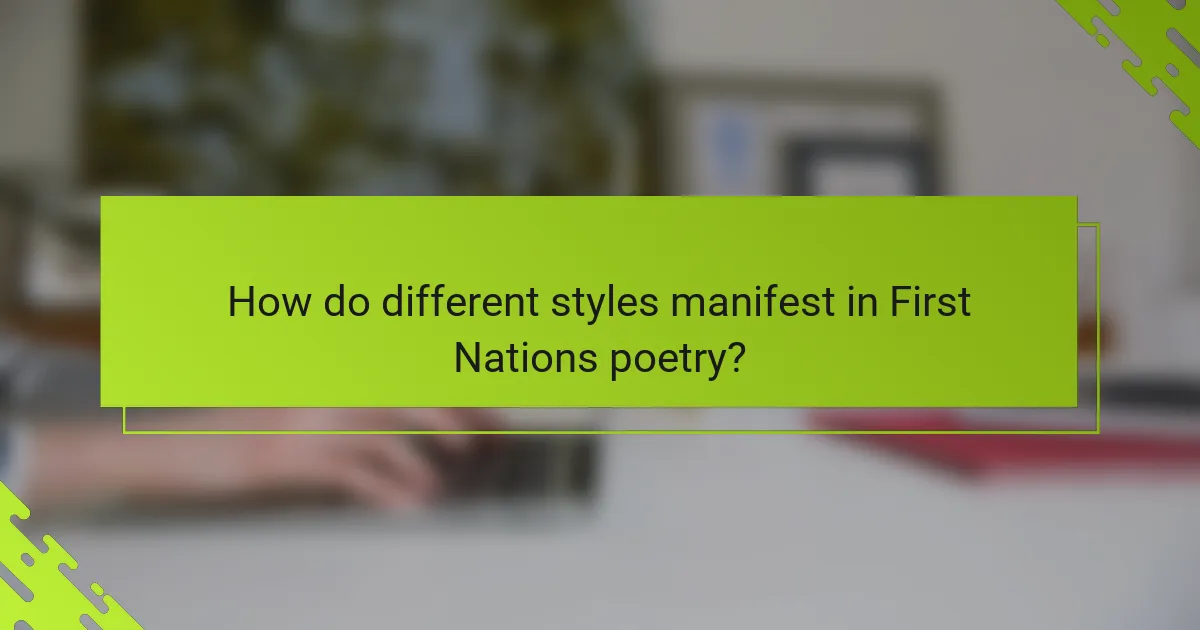
How do different styles manifest in First Nations poetry?
Different styles manifest in First Nations poetry through diverse voices, cultural narratives, and unique linguistic expressions. These elements reflect the rich heritage and contemporary issues faced by Indigenous communities. For instance, oral traditions often influence the rhythmic and thematic structure of poems, while contemporary works may incorporate modern themes and styles, showcasing a blend of traditional and current influences. The use of metaphor and symbolism is prevalent, often drawing from nature and personal experiences, which enhances the emotional depth and cultural significance of the poetry.
What are the unique stylistic elements found in various regions?
First Nations poetry showcases unique stylistic elements that vary by region, reflecting cultural diversity. These elements include oral traditions, use of metaphors, and incorporation of nature imagery.
In the Northwest Coast, for instance, poetry often emphasizes storytelling and community. The Plains region highlights rhythmic patterns and repetition, creating a musical quality. In contrast, Eastern Woodlands poetry may focus on personal experiences and contemporary issues, blending traditional themes with modern perspectives.
Overall, these stylistic variations illustrate the rich tapestry of First Nations voices, each contributing to a broader understanding of their cultural heritage.
How do modern influences blend with traditional forms?
Modern influences enrich traditional First Nations poetry by incorporating contemporary themes, styles, and mediums. This blend fosters a dynamic dialogue between past and present, allowing poets to address current issues such as identity, land rights, and cultural preservation. For example, spoken word and digital platforms expand the reach of these voices, making poetry more accessible. This fusion highlights the evolving nature of First Nations art while honouring its roots.
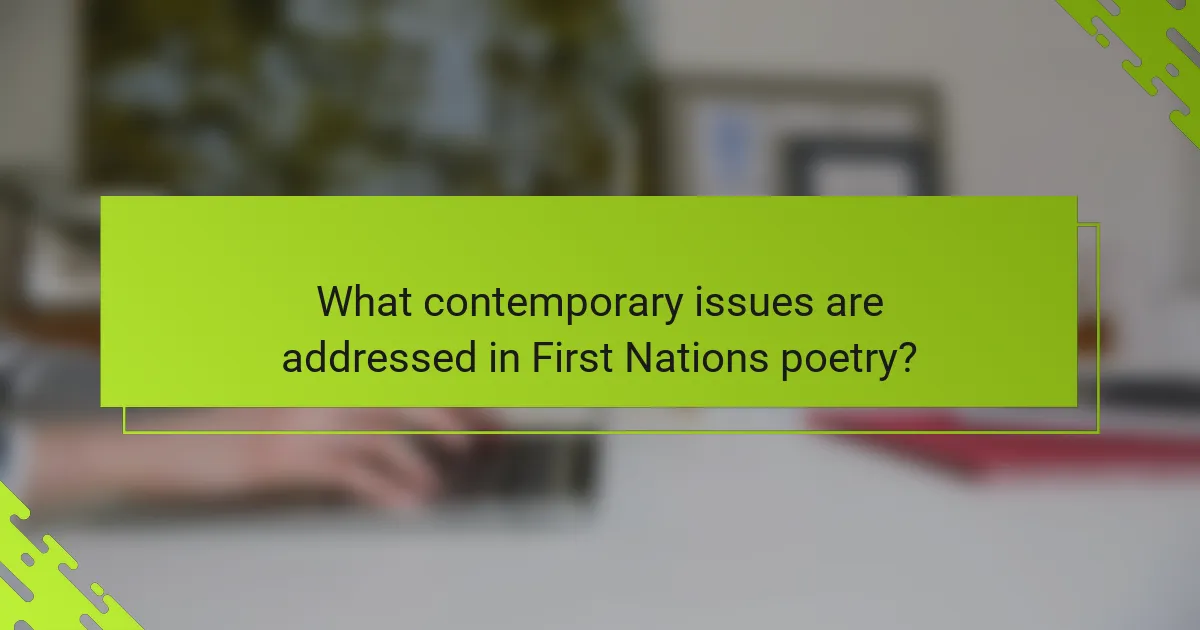
What contemporary issues are addressed in First Nations poetry?
First Nations poetry addresses contemporary issues such as identity, cultural preservation, social justice, and environmental concerns. Poets express the struggles and resilience of Indigenous communities through their works. Themes often include the impact of colonization, the importance of language, and the fight for rights and recognition. These poems serve as powerful tools for advocacy and healing, reflecting the voices of First Nations people in today’s society.
How do poets respond to social justice and activism?
Poets respond to social justice and activism by using their art to amplify marginalized voices. First Nations poetry often addresses contemporary issues such as land rights, cultural preservation, and identity. Through varied styles, these poets challenge systemic injustices and inspire action. Their work reflects unique attributes like oral traditions and community storytelling, which resonate deeply with audiences. This poetry serves as a powerful tool for activism, fostering awareness and encouraging societal change.
What role does identity play in modern poetic narratives?
Identity plays a crucial role in modern poetic narratives, particularly in First Nations poetry, by expressing cultural heritage and personal experiences. Poets use their voices to reflect on contemporary issues, blending traditional styles with modern themes. This interplay highlights unique attributes of identity, such as resilience and connection to land, while addressing rare experiences faced by Indigenous communities today. As a result, First Nations poetry serves as a powerful medium for storytelling and advocacy, enriching the literary landscape with diverse perspectives.

How is First Nations poetry received and celebrated globally?
First Nations poetry is celebrated globally for its rich cultural heritage and contemporary relevance. It resonates through diverse voices and styles that reflect the unique experiences of Indigenous peoples.
Global recognition of First Nations poetry has increased due to its themes addressing social justice, identity, and environmental issues. Events like poetry slams and festivals showcase Indigenous poets, fostering cross-cultural dialogues.
The use of traditional languages in poetry enhances its authenticity and connects audiences to Indigenous worldviews. This practice enriches the global literary landscape, allowing for a deeper understanding of First Nations cultures.
Moreover, digital platforms amplify these voices, reaching wider audiences and promoting inclusivity. Social media and online publications serve as vital spaces for sharing and celebrating First Nations poetry on a global scale.
What festivals and events showcase First Nations poets?
First Nations poets are showcased at various festivals and events across Canada. Notable examples include the Indigenous Writers’ Gathering, the Vancouver Writers Fest, and the Toronto Indigenous Arts Festival. These events highlight diverse voices and contemporary issues in First Nations poetry. They provide platforms for both established and emerging poets to share their work and connect with audiences.
Which platforms are most effective for sharing their work?
Social media platforms, literary websites, and community forums are most effective for sharing First Nations poetry.
Platforms like Instagram and Facebook allow poets to reach wider audiences through visual storytelling and engagement. Websites such as Wattpad and Medium provide spaces for longer works and discussions. Community forums, including Indigenous-focused sites, foster connections and promote cultural exchange. Each platform supports unique attributes, such as accessibility and audience interaction, enhancing the visibility of First Nations voices.
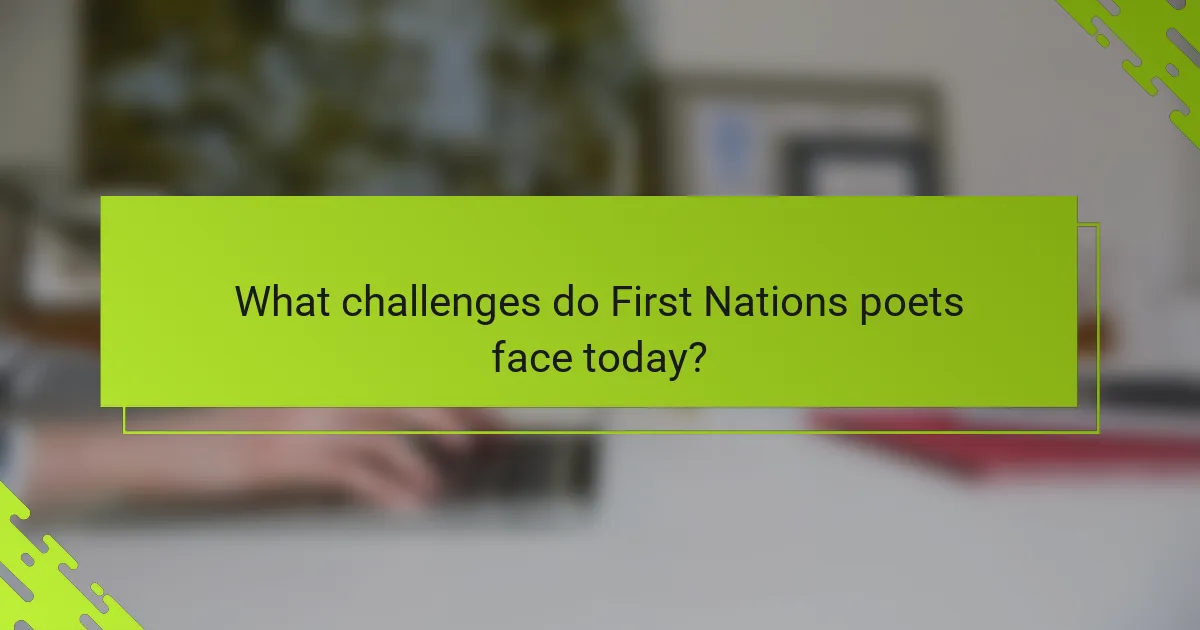
What challenges do First Nations poets face today?
First Nations poets face challenges such as cultural appropriation, limited access to publishing opportunities, and the struggle to balance tradition with contemporary expression. These obstacles hinder their visibility and recognition in the literary world. Additionally, systemic issues, including underfunding and lack of representation, further complicate their artistic journeys.
How does access to resources impact their work?
Access to resources significantly enhances the effectiveness of First Nations poets. Availability of funding, mentorship, and platforms allows for greater visibility and expression of their unique voices. These resources foster creativity and enable the exploration of contemporary issues within their work. For instance, workshops and community programs provide essential support, helping poets refine their craft and connect with audiences.
What barriers exist in the publishing industry?
Barriers in the publishing industry for First Nations poetry include limited access to publishing resources, cultural misrepresentation, and inadequate representation in mainstream platforms. These obstacles hinder the visibility and distribution of Indigenous voices. Additionally, there is often a lack of understanding of the unique styles and themes present in First Nations poetry, which can lead to underappreciation and misinterpretation. As a result, many talented poets struggle to gain recognition and support.
How can poets navigate cultural appropriation concerns?
Poets can navigate cultural appropriation concerns by engaging with First Nations communities and respecting their traditions. Building genuine relationships fosters understanding and authenticity in poetic expression. Poets should prioritize research and education on cultural contexts, ensuring they honour the heritage and voices of Indigenous peoples. Acknowledging sources and influences in their work demonstrates respect and accountability.
What best practices can enhance the visibility of First Nations poetry?
Promoting First Nations poetry requires strategic visibility practices. Engaging with local communities enhances outreach. Collaborating with educational institutions can integrate poetry into curricula, fostering appreciation. Utilizing social media platforms amplifies voices, sharing works widely. Hosting poetry readings and festivals showcases talent, attracting diverse audiences. Leveraging partnerships with cultural organizations strengthens support networks.
